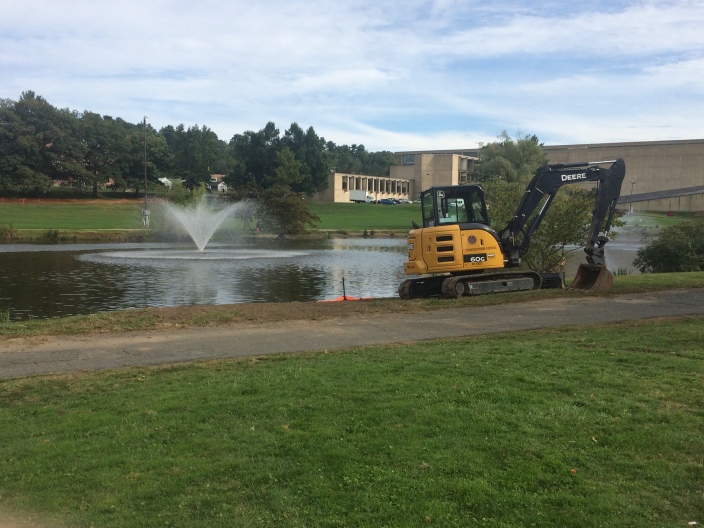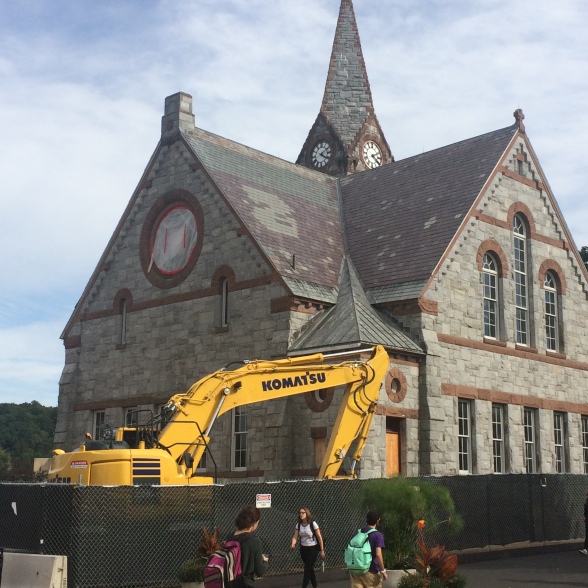UMass construction: Worth the time, effort and money?
On a bike ride to class through North Pleasant Street – the hub of traffic on the University of Massachusetts Amherst campus – senior David Stidham recently witnessed severe congestion.
“I zipped by traffic at a complete standstill,” Stidham said.
The history major, who headed to his class in Herter Hall on a mid-September day, said that “within the next 20 minutes, 10 students [had come] in late complaining about the traffic being blocked and [said] the busses couldn’t move.”
Stidham and his classmates experienced an increasingly common inconvenience on campus this semester: navigating around a construction site.
An unprecedented number of big construction projects are underway on campus: the Integrated Design Building across from the Fine Arts Center; the Champions Center, an athletic facility across from the Mullins Center; the Physical Sciences Building; and an addition to South College. Across from South College, Old Chapel is undergoing a makeover. And at the Robsham Visitor’s Center Parking Lot, a solar canopy is nearly completed.
The work will continue into 2016, with the exception of the Physical Sciences Building, which is scheduled to open in 2018. These projects will cost over $1.3 billion, according to the university’s capital plan.
Student opinions vary about all the new construction. Sophomore Brian Griffin, who describes the campus-wide construction as a “nuisance,” confirms that it makes it much harder to navigate the university. But others say all the new buildings will benefit the university in the long run.

“It’s bad enough that the campus is so large that you have to walk a good distance. Now you have to walk around the construction,” said Griffin, an accounting major.
Freshman Laura Barkowski remembered getting lost on her way to a seminar in Lederle Graduate Research Center because the front entrance was completely blocked off.
“I feel like things are already confusing enough. Now, some pathways are shut down so it’s harder to get places,” said Barkowski.

Facilities and Campus Services communication manager Jim Hunt said that students should focus on the positive: new buildings ultimately make UMass a more desirable place to be.
“As much of a pain as it is, we should all consider ourselves very lucky,” said Hunt. “We could be sitting in a university that was forgotten… And that’s a lot worse.”
Some students agree.
“I’m okay with it,” senior Matt Kilroe said, “As long as [the university] is making the school bigger and better and making my degree look better in the future.”
The projects are part of the university’s five-year capital plan and address specific strategic priorities, says Interim Director of Campus Services Shane Conklin. These include attracting the best students and faculty, increasing research, improving living and learning on campus.
“In general, we identify projects that bring the best investment to the campus,” said Conklin.
The majority of current projects are funded by the University of Massachusetts Building Authority, or the UMBA.
In a phone interview, Joanna Aalto, treasurer of UMBA and director of construction audits, explained that the UMBA borrows the funds using tax-exempt bonds, and issues the bonds to the university, which pays back the fees over time.

The signs in front of the construction sites all mention that the projects are funded by the UMBA, but do not include how those bonds are paid back. Students sometimes question where this money comes from.
According to Assistant Budget Director Lynn McKenna, the university pays about $70 million per year on the bonds.
“Currently about $48 million this year is going to come out of our general funds, funded predominately by student tuition and fees,” McKenna said.
In addition to the finances, the time and effort of the projects must be considered. One thing students are wondering: Why is all of this construction happening at once?
“Money is cheap right now,” Hunt said. “Interest rates are at a near zero… That isn’t always the case… If you can, now is the time to do it.”
Hunt said all of the projects are “very much in need.”
“Point a building out to me and say, ‘Well, we could have done without that,'” he challenged. “I think you would have a hard time finding it.”
Email Haley Bucelewicz at [email protected].


